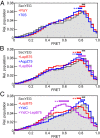Lateral gate dynamics of the bacterial translocon during cotranslational membrane protein insertion
- PMID: 34162707
- PMCID: PMC8256087
- DOI: 10.1073/pnas.2100474118
Lateral gate dynamics of the bacterial translocon during cotranslational membrane protein insertion
Abstract
During synthesis of membrane proteins, transmembrane segments (TMs) of nascent proteins emerging from the ribosome are inserted into the central pore of the translocon (SecYEG in bacteria) and access the phospholipid bilayer through the open lateral gate formed of two helices of SecY. Here we use single-molecule fluorescence resonance energy transfer to monitor lateral-gate fluctuations in SecYEG embedded in nanodiscs containing native membrane phospholipids. We find the lateral gate to be highly dynamic, sampling the whole range of conformations between open and closed even in the absence of ligands, and we suggest a statistical model-free approach to evaluate the ensemble dynamics. Lateral gate fluctuations take place on both short (submillisecond) and long (subsecond) timescales. Ribosome binding and TM insertion do not halt fluctuations but tend to increase sampling of the open state. When YidC, a constituent of the holotranslocon, is bound to SecYEG, TM insertion facilitates substantial opening of the gate, which may aid in the folding of YidC-dependent polytopic membrane proteins. Mutations in lateral gate residues showing in vivo phenotypes change the range of favored states, underscoring the biological significance of lateral gate fluctuations. The results suggest how rapid fluctuations of the lateral gate contribute to the biogenesis of inner-membrane proteins.
Keywords: YidC; membrane proteins; ribosome; single-molecule biophysics; translocon SecYEG.
Copyright © 2021 the Author(s). Published by PNAS.
Conflict of interest statement
The authors declare no competing interest.
Figures







References
-
- Denks K., et al. ., The Sec translocon mediated protein transport in prokaryotes and eukaryotes. Mol. Membr. Biol. 31, 58–84 (2014). - PubMed
-
- Steinberg R., Knüpffer L., Origi A., Asti R., Koch H. G., Co-translational protein targeting in bacteria. FEMS Microbiol. Lett. 365, 365 (2018). - PubMed
-
- Denks K., et al. ., The signal recognition particle contacts uL23 and scans substrate translation inside the ribosomal tunnel. Nat. Microbiol. 2, 16265 (2017). - PubMed
Publication types
MeSH terms
Substances
LinkOut - more resources
Full Text Sources

